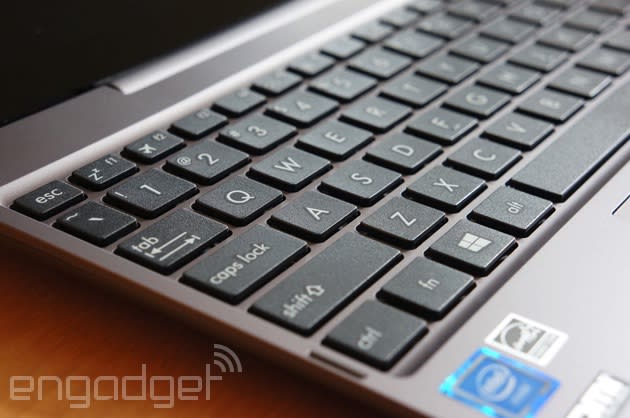ASUS' $299 hybrid tablet is a good idea that's past its prime

When ASUS launched the original Transformer Book T100 back in 2013, it had a relatively novel concept on its hands: a low-cost Windows tablet that could double as a laptop thanks to its included dock. The company clearly thinks it's still a good idea, since it recently released the Transformer Book T100HA with more powerful guts and Windows 10. But does this concept still hold water in 2015, when 2-in-1 Windows laptops are commonplace and mobile tablets are increasingly powerful? I've been living with the T100HA for several weeks to find out, and the truth is that it's no longer as sweet a deal as it once seemed. There are still many things to like about ASUS' hybrid, but you'll have to make some compromises that shouldn't really be necessary in modern hardware.
Some of those sacrifices are clear from the outset, starting with the design. Externally, the T100HA hasn't changed much compared to the Windows 8-based T100. It still has that familiar 10.1-inch, 1,280 x 800 display and matching keyboard dock. The biggest differences are the addition of a USB Type-C port (which isn't very useful to me right now, unless I buy a new Nexus phone) and a button-free tablet release mechanism. It's very easy to carry around -- the system weighs 2.3 pounds with the dock -- but it also leaves me trying do all my computing on a small, low-resolution display. I found this acceptable in pure tablet mode, but the laptop mode felt cramped, like an uncomfortable flashback to the netbook's heyday. It's time to give the T100 series a proper redesign, ASUS, starting with the screen.
The signature keyboard dock doesn't help with that claustrophobic feeling. It's entirely possible to type quickly on this smallest of Transformer Books, and the trackpad is quite usable despite its tiny size (although some scrolling gestures would help). However, that doesn't mean that you'll be enthralled with it. The small keys meant that I had to always be mindful of where my fingers were, while a full-size keyboard would let me relax. And did I mention that those keys are loud and spongy, too? The dock is still helpful for writing those long messages, but it's a joyless experience that's in need of an overhaul.

Things get better under the hood. Frankly, I'm impressed that ASUS stuffed 4GB of RAM and 64GB of flash storage into a 2-in-1 at this price. The T100HA probably isn't going to be your one and only PC, but I didn't have problems juggling multiple apps at once or finding room for downloads. And there's no denying that this is a poster child for what Windows 10's Continuum feature can do. It's a low-cost hybrid that works well for YouTube on the couch, but kicks into full desktop mode when I need to get some serious work done... like, say, writing this article.
With that said, there are limits to how well the Transformer Book performs. Windows 10's side-by-side app multitasking is only occasionally useful at this size and with such a low-res display. More importantly, you can't help but notice the performance limits of the 1.44GHz Atom x5 processor. The T100HA may have enough RAM to run multiple apps without bogging down, but it's never especially quick at anything. Apps tend to chug longer than I'd like, whether they're loading websites or playing media. At least the battery life is relatively good. ASUS' claim of a 12-hour runtime isn't very realistic unless you're only watching video: the Transformer Book ran for 11 hours and 20 minutes (not far off from the original T100) in our video test, which loops a 1080p clip at 50 percent brightness with WiFi on. However, it's still feasible to get several hours when you're juggling web surfing, Twitter and the other lightweight tasks you're likely to perform on a device like this. That's not spectacular, but it's enough to get through a busy work day.

The problem, as you may have guessed, is that battery life is one of the few areas where you get what you'd expect from a conventional $299 PC. I'm giving up a lot to get a touchscreen tablet at this price; comfort, performance and visibility all take a back seat. A comparable laptop would get me a nicer keyboard, a faster processor and a bigger, sharper screen. While that's true of many hybrids, the gap is particularly noticeable at this level: It's the difference between a small, slow companion device and something powerful enough to be my only computer. And while it's harder to get a Windows 10 tablet at this size and price, there are plenty of tablets (think Android and iPads) with better specs for the money.
The T100HA and its compact, detachable form factor still make sense to me, but only in specific circumstances -- it doesn't feel like the do-it-all wonder that the first T100 represented two years ago. It's best as an around-the-house tablet that occasionally turns into a PC when you need to churn out long email replies or school reports. It was great when I just wanted to curl up with a video or look something up, but it was lousy when I tried to treat it as a full-fledged laptop replacement. If you're in that boat, you're probably better off paying a little extra for a 2-in-1 laptop that makes fewer sacrifices, like HP's Pavilion x360. That kind of system may be bulkier and less flexible, but I suspect you'd be happier overall. Their larger, faster designs feel better-suited to modern tasks, while the T100HA comes across as something of a throwback.



























